Kurt Gänzl
The Encyclopedia of the Musical Theatre
13 January 2020
The team responsible for that overwhelming hit of 1926, The Desert Song, mined a similar vein for their next collaboration, The New Moon, a romantic operetta set in the Naughty Marietta precincts of 18th-century New Orleans. In contrast to Naughty Marietta, this time it was the leading man, Robert Misson, rather than the heroine who was on the run from Europe, having sold himself into colonial servitude to escape arrest for the murder of a royal rapist.
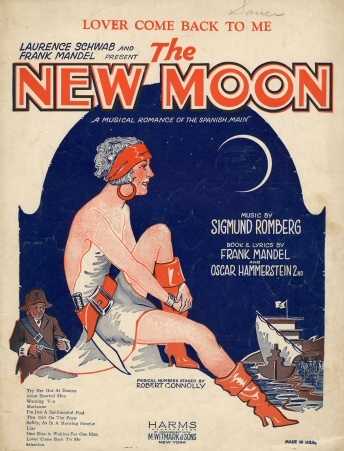
Sheet music cover for “Lover Come Back to Me” from “New Moon”.
He is engaged as steward in the home of Beaunoir family, where he falls in love with the aristocratic Marianne and where, evetually, the French policeman Ribaud tracks him down. Misson pirates the ship taking him back to France and trial, and he and his anti-Royalist followers sail it to an unoccupied island. There they establish a new colony where all men are equal, except of course, Robert Misson.
When the French invade, however, it turns out that things have changed. They now represent not the bad old King but the nice new Republic. Marianne is expediently converted to being Citizeness Misson, Ribaud, refusing to bow to the mob, is condemned, and Misson, named Governor of his island (since Kings are now not allowed), settles down for a happy ending with his men and his Marianne.
The show was produced in Philadelphia, which had given such a tremendous welcome to Romberg’s My Maryland earlier the same year, with Robert Halliday as Misson, Desirée Tabor (quickly replaced by Jessie Royce Landis) as Marianne, and William O’Neal (Philippe), William Wayne (Alexander), Margaret Irving (Madame Duchêne) and Walter Brennan as Girard, supporting.
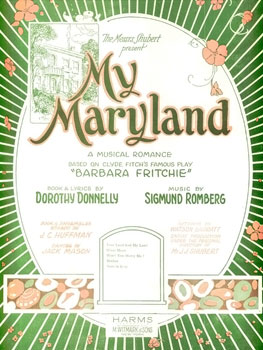
Sheet music cover for Romberg’s “My Maryland.”
New Moon did not win the same response that My Maryland had, and Schwab and Mandel decided to close the production down rather than to fiddle with it on what looked like a rocky road to town. For seven months The New Moon went back into the workshop and Romberg, with the five other musicals on which he had worked during 1927 finally out of the way, devoted himself to rewriting his score.
Out went Julie and Alexander’s ‘When I Close My Eyes’ and Robert and Marianne’s ‘Neath a New Moon’ (leaving the show’s title now referring only to the name of a ship!), Marianne’s ‘La, la, la, la’ and ‘A Voice in the Dark’, Besace’s sea shanties and ‘Women, Women, Women’, Robert’s ‘I Love You’, Mme Duchêne’s praises of ‘Paris’, ‘I’m Just a Sentimental Fool’ and ‘Liar’, leaving the stirring march ‘Shoulder to Shoulder’ (later rechristened ‘Stout hearted Men’) and the comical ‘Try Them Out at Dancing’ (sic) from the original set of songs to be supplemented with more than half a score of new music.
The additions included the heroine’s waltz ‘One Kiss’ and the love song ‘Lover, Come Back to Me’, the soaring duet ‘Wanting You’ and one of Romberg’s and, certainly, of Hammerstein’s, most beautiful songs, ‘Softly as in a Morning Sunrise’, sung not by either of the stars but by the tenor Philippe, an accessory to Misson’s crime who has turned ‘republican’ through sexual jealousy, sighing, in his American exile, over all that his foolishness has lost him.
On 27 August 1928 the producers reopened the much-altered show in Cleveland (even though they were opening Hold Everything! at virtually the same time in Newark), with Evelyn Herbert (Marianne), Robert Halliday (Misson), William O’Neal (Philippe) and Max Figman (Ribaud) in the dramatic rôles and Gus Shy heading the incidental comedy. Former D’Oyly Carte tenor Pacie Ripple played Beaunoir.
In a few weeks The New Moon was on Broadway, and Schwab and Mandel’s decision to stop and rewrite was fully justified. The New Moon effaced the disappointments of Romberg’s My Princess and The Love Call, scored a splendid success and finished by totting up an even longer Broadway run than The Desert Song with a total of 509 performances at the Imperial Theater.
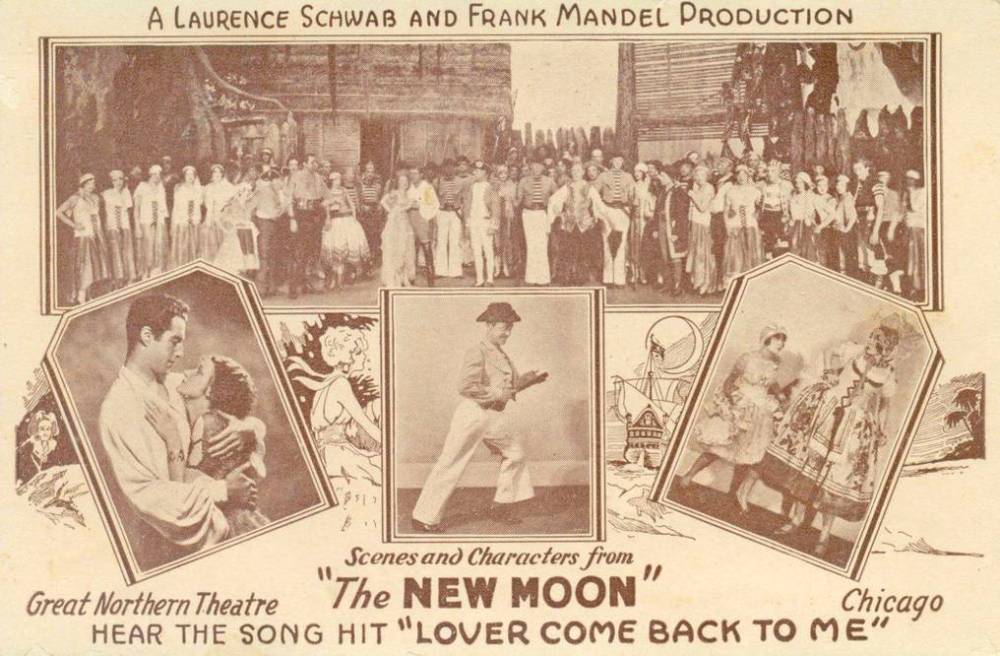
A postcard with scenes from the Chicago production of “The New Moon.”
Before even Broadway’s production had closed, The New Moon was mounted at London’s Theatre Royal, Drury Lane, following behind Rose Marie, The Desert Song and Show Boat at what had become the headquarters of the best of Broadway operetta in the West End.
Howett Worster (Misson), Evelyn Laye (Marianne), Ben Williams (Philippe), Edmund Willard (Ribaud) and Gene Gerrard (Gus) headed the cast with Vera Pearce as Clotilde, but The New Moon proved not to have the same attractions for London as the previous pieces had had. It lasted only 148 performances and marked up the theatre’s first failure with an American musical spectacular play. Paris, which similarly saw the show in the wake of Show Boat (rechristened Mississippi for France), gave a warmer welcome to a version more explicitly retitled Robert le Pirate (ad Albert Willemetz). Here the figures were reversed, and Robert le Pirate, with the rising baritone André Baugé starred alongside the striking soprano Danielle Brégis and the comic Bach, played 237 times on the Châtelet’s vast stage where the disappointing Mississippi had been seen just 115 times.
Like Britain, Australia reacted slightly disappointingly to The New Moon, especially given the huge local popularity of The Desert Song. J C Williamson Ltd’s production, starring The Desert Song‘s hero Lance Fairfax, Marie Bremner (Marianne), Frederick Bentley (Gus), Herbert Browne (Philippe) and Vera Spaull (Clotilde), played only a single Sydney season before it was replaced by a revival of The Belle of New York. Sydney Burchall took over as Misson for seven weeks in Melbourne (Theatre Royal, 19 July 1930).
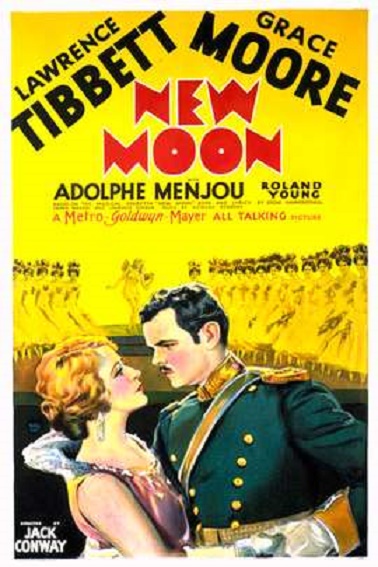
Poster for the film version of “The New Moon§ starring Grace Moore and Lawrence Tibbett, plus Adolphe Menjou as the Governor.
However, The New Moon and, most especially, its music were still destined to be received as classics throughout the English-speaking world and, as in the case of Naughty Marietta, it was the cinema which was largely responsible for this.
The first film version, with Grace Moore and Lawrence Tibbett starred, Adolphe Menjou as the Governor and Gus Shy, Roland Young and Emily Fitzroy at the head of the comedy, used only a little of Romberg’s score attached to a wholly different story which transported the action to the Caspian sea and turned her into yet another Princess and him into yet another hussar. She got to sing ‘Lover Come Back to Me’.
However, a Nelson Eddy-Jeanette MacDonald movie of 1940 returned to a version much more like the stage show and found much more success.
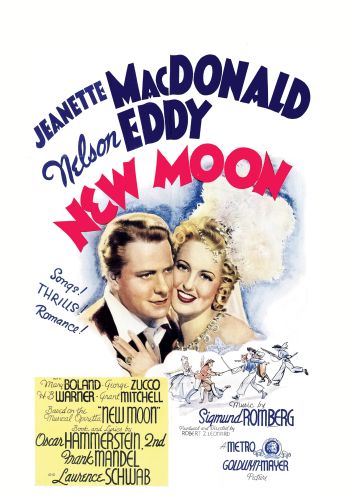
Poster for the film version of “The New Moon” starring Jeanette MacDonald and Nelson Eddy.
Eddy and Miss MacDonald imprinted their performances on to the material and ensured The New Moon regular future productions – beginning with performances at Carnegie Hall (18 August 1942) and the New York City Center (17 May 1944) – which have continued, largely in regional and amateur circumstances, to the present day. The New York City Opera’s production was televised in 1989.
The title The New moon was previously used for an ‘operaic fancy’ by R André and Isidor de Solla produced at the Savoy Hotel, London 6 February 1893 with Richard Temple amongst the cast.
UK: Theatre Royal, Drury Lane 4 April 1929; France: Théâtre du Châtelet Robert le Pirate 20 December 1929; Australia: Her Majesty’s Theatre, Sydney 4 January 1930; Film: MGM 1930, MGM 1940

I very much enjoyed Tibbett and Moore (I used to have a copy of her film of the opera “Louise”). “Wanting you”bore some resemblance to the original number.
We need modern complete recordings with the composer’s arrangements.or arrangements of the composer’s period.
Does anyone know if either the original New York Philippe (William O’Neal) or the original London Philippe (Ben Williams) recorded “Softly, As In a Morning Sunrise”?
I’ve just noticed that William O’Neal’s recording is on YouTube.
I’ve written an article on the ways that singers have changed the lyrics of this operetta’s two most famous songs:
https://www.allaboutjazz.com/the-lyrics-they-are-a-changing-lyrical-liberties-in-lover-come-back-to-me-and-softly-as-in-a-morning-sunrise
“I’m actively searching for the orchestration of the piece ‘I’m Just a Sentimental Fool’ by Sigmund Romberg. Does anyone have a lead on where to find it? Thank you very much.”